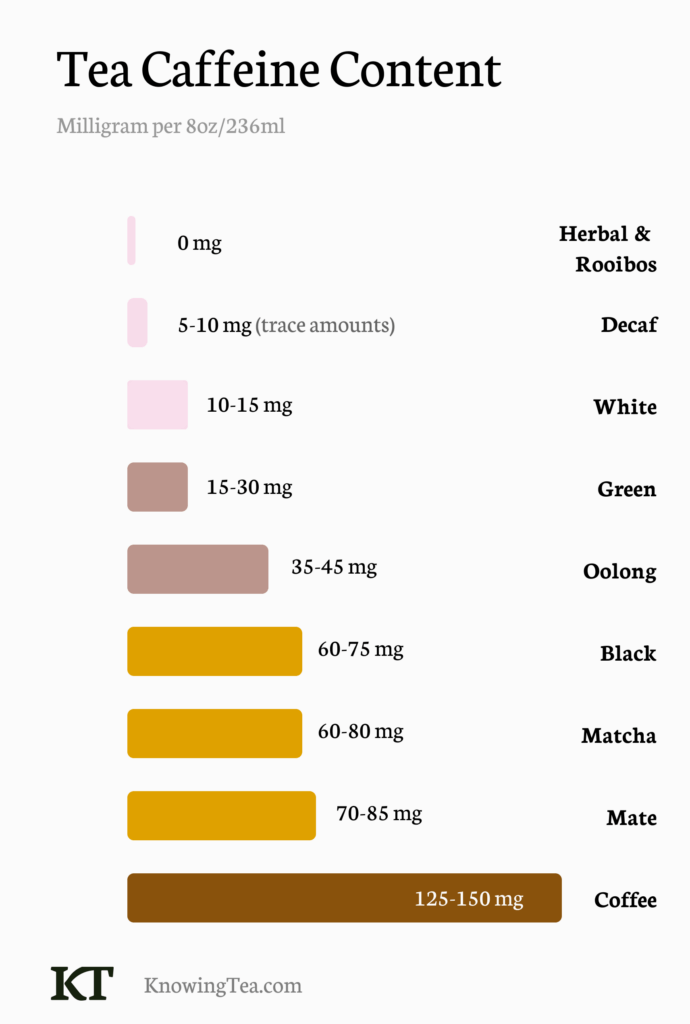Caffeine in tea exists as a natural compound that has captivated societies for centuries with its stimulating effects. Its presence varies widely across tea types, influenced by factors such as the plant’s variety, the terroir, the meticulousness of harvest and processing, and the preparation of the infusion itself.
Tea Types: A Caffeine Comparison
The caffeine landscape across tea types is diverse, with certain teas standing out for their relatively high or low caffeine content, from the potent Matcha to the milder Hojicha.

The Intricacies of Tea Varietals
The Camellia sinensis plant gifts us with caffeine but does so variably through its two primary varietals: Camellia sinensis var. sinensis, more delicate and lower in caffeine, and Camellia sinensis var. assamica, robust and higher in caffeine content.
The Influence of Harvest
The timing of the tea harvest plays a pivotal role. The tender buds of spring, particularly in premium white teas like Jasmine Silver Needle, are replete with caffeine, ready to awaken the senses.
Shaded Growth: A Catalyst for Caffeine
Teas cultivated in the shade, such as the esteemed Japanese Gyokuro, undergo a transformative process, amplifying their caffeine content as a response to the lack of sunlight, enhancing not just caffeine but also l-theanine and chlorophyll.
The Role of Processing
The way leaves are treated post-harvest can alter caffeine levels. Mechanically altered leaves, through cutting or crushing, can yield a more potent caffeine brew, whereas whole leaves often result in a milder concoction.
Water Temperature’s Effect
Hotter water acts as a conduit, extracting more caffeine. Thus, teas brewed at higher temperatures typically offer a more caffeinated cup.
Steep Time: A Dial for Caffeine
The duration of steeping is directly proportional to the caffeine extracted. A prolonged immersion means a more caffeinated beverage, a detail particularly pertinent to black and pu-erh teas.
The Quantity of Leaves
More leaves equate to more caffeine—simple mathematics for tailoring a tea’s strength to personal preference.
Understanding Caffeine Content Across Tea Types
Generalizations about caffeine content in tea categories can be helpful but are often incomplete. While black teas, brewed hot and long, are on the higher end of the caffeine spectrum, and green and white teas, prepared more gently, tend to be lower, this is a simplification.
The nuances of each tea’s origin, treatment, and preparation mean that caffeine levels are a complex symphony rather than a straightforward scale.
The Experience of Caffeine in Tea Versus Coffee
Caffeine may be shared between tea and coffee, but the experience differs. Tea’s lower caffeine content per cup, the calming presence of l-theanine, and the gradual absorption facilitated by antioxidants contribute to a more balanced uplift than coffee’s brisk jolt.
The Myth of Tea’s Caffeine Superiority Over Coffee
While dry tea leaves contain a substantial amount of caffeine, the brewed reality paints a different picture—a cup of tea typically has less caffeine than a cup of coffee due to differences in preparation and quantity used.
The Leaf’s Position: A Caffeine Indicator
Caffeine concentration is higher in the youngest leaves, perched at the apex of the tea bush, which also boast a rich antioxidant profile.
Debunking Oxidation Misconceptions
Oxidation, a stage in tea processing, doesn’t increase caffeine content; this myth stems from misinterpreting the higher caffeine content in traditionally fully oxidized black teas, which is actually due to typical brewing methods.
The Impact of Tea Bag Versus Loose Leaf
Tea bags often result in a higher caffeine infusion due to the smaller size of the leaves, while loose leaf teas offer a more nuanced and typically milder caffeine experience.
Caffeine Sensitivity and Decaf Options
Individual caffeine tolerance can vary dramatically. While decaffeinated teas offer lower caffeine options, they are not completely caffeine-free, and a brief initial steeping won’t significantly reduce caffeine content.
Herbal Teas: The Caffeine-Free Haven
For those seeking to avoid caffeine entirely, herbal teas, which are not derived from Camellia sinensis, provide a delightful and diverse caffeine-free universe.
Caffeine’s Symphony with the Body
Caffeine’s effects are a personal affair, with its stimulating properties cherished by many. However, mindfulness towards one’s unique reaction to caffeine and moderation in consumption is crucial for a harmonious relationship with this enigmatic alkaloid.
In conclusion, tea offers a versatile canvas for caffeine consumption, from the gently stimulating to the robustly invigorating. Understanding the multifaceted nature of caffeine in tea enables one to navigate this world with an informed appreciation, tailoring the tea-drinking experience to one’s physiological rhythm and life’s tempo.

